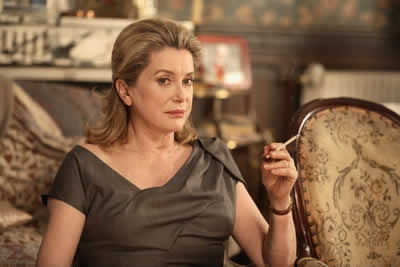 A Christmas Tale is story of Junon (Catherine Deneuve) and Abel (Jean-Paul Roussillon) the parents of three grown children: Elizabeth (Anne Consigny), a melancholic playwright with a mathematician husband (Hippolyte Girardot) and a tortured teenage son, Paul (Emile Berling); Henri (Mathieu Amalric), the self-destructive black sheep, banished from family events by Elizabeth five years prior; youngest Ivan (Melvil Poupaud), the peacemaker, is married to the beautiful Sylvia (Chiara Mastroianni) and has two eccentric little boys; while a fourth – Joseph, the eldest – died from leukemia as a boy. When the disease reappears again in the family, all are tested to see who can be a donor, and then everyone – including lovesick cousin Simon (Laurent Capelluto) and Henri’s girlfriend, Faunia (Emmanuelle Devos) – return home for a long Christmas weekend. All crowded again under the same roof, solidarity quickly – and hilariously – devolves into feuding, drunkenness and bed-hopping, as everyone struggles to make sense of the mysteries of family, life, and what lies ahead.
A Christmas Tale is story of Junon (Catherine Deneuve) and Abel (Jean-Paul Roussillon) the parents of three grown children: Elizabeth (Anne Consigny), a melancholic playwright with a mathematician husband (Hippolyte Girardot) and a tortured teenage son, Paul (Emile Berling); Henri (Mathieu Amalric), the self-destructive black sheep, banished from family events by Elizabeth five years prior; youngest Ivan (Melvil Poupaud), the peacemaker, is married to the beautiful Sylvia (Chiara Mastroianni) and has two eccentric little boys; while a fourth – Joseph, the eldest – died from leukemia as a boy. When the disease reappears again in the family, all are tested to see who can be a donor, and then everyone – including lovesick cousin Simon (Laurent Capelluto) and Henri’s girlfriend, Faunia (Emmanuelle Devos) – return home for a long Christmas weekend. All crowded again under the same roof, solidarity quickly – and hilariously – devolves into feuding, drunkenness and bed-hopping, as everyone struggles to make sense of the mysteries of family, life, and what lies ahead.
Arnaud Desplechin studied film directing at the University of Paris III: Sorbonne Nouvelle, graduating in 1984. He made three short films inpired by the work of the Belgian novelist Jean Ray, and became a great admirer of the films of Alain Resnais. During the late 1980s,
Desplechin’s first feature-length movie, La Sentinelle, premiered in 1992. His1996 film Comment je me suis disputé… (ma vie sexuelle) was a critical success and established Desplechin as an important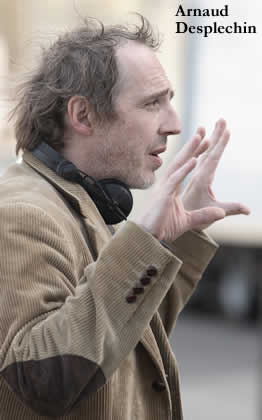 director for the 1990s. In 2000, Desplechin made his first English-language film, Esther Kahn, adapted from a novel by Arthur Symons. Three years later, Desplechin made two films adapting Edward Bond’s play In the Company of Men. The next year, he directed Kings and Queen, which mixed comedy and tragedy to tell the story of two ex-lovers played by Amalric and Devos. In 2007, Desplechin filmed L’Aimée, a documentary showing his father, his brother, and his nephews in the family house in Roubaix just before it was to be sold. That same year, he filmed the family drama Un conte de Noël, ( A Christmas Tale) starring Deneuve, Amalric, Devos, and Mastroianni. This film was screened in competition at Cannes in 2008. (Wikipedia)
director for the 1990s. In 2000, Desplechin made his first English-language film, Esther Kahn, adapted from a novel by Arthur Symons. Three years later, Desplechin made two films adapting Edward Bond’s play In the Company of Men. The next year, he directed Kings and Queen, which mixed comedy and tragedy to tell the story of two ex-lovers played by Amalric and Devos. In 2007, Desplechin filmed L’Aimée, a documentary showing his father, his brother, and his nephews in the family house in Roubaix just before it was to be sold. That same year, he filmed the family drama Un conte de Noël, ( A Christmas Tale) starring Deneuve, Amalric, Devos, and Mastroianni. This film was screened in competition at Cannes in 2008. (Wikipedia)
Bijan Tehrani: How did you come up with the story for this film?
Arnaud Desplechin: I don’t know. I usually start with lines that I am thinking about here and there. I start with those lines that obsess me, which are the lines like the father in the graveyard speaking about the death of his son, or something like that. I loved these lines because I didn’t understand them, but they just sound poetic to me. So I just try to think if it is good material for an actor. After that, I continue the writing process. I had the loneliness of the father and the idea that it would be a family gathering for Christmas, because I thought it would be funny to do a kind of Thanksgiving French movie. I am mixing all these ideas. I discovered this idea of the marrow transplants, which is very strange. I mix all these things to find a pattern, which unifies everything.
BT: I found that the film has a very interesting structure. It has the structure of a classic film, but at the same time contains some loose elements.
AD: Yea, it kind of sounds like a joke, but I am doing a Thanksgiving movie. This is what it is, a classic genre. After that, it is quite tricky not to write clichés when you have such a classic structure. After that, I had to try to invent new patterns in a form which has been used so many times on screen. I had to find new ways to tell a very old story, which is a story of a family gathering and having arguments. So, yea, that was how we proceeded.
BT: Another aspect of the film that is very interesting is how there are so many characters, yet you give them all the same amount of value and we don’t get lost between them. There are many American movies that have like twenty stars that are all given the same value, but you never like any of them. In this, film you get to know every one of them and care for them. How did you manage to pull this off? 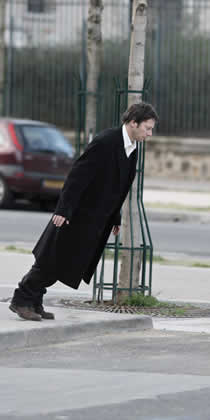 AD: During the writing process, we tried to figure out what each character could say that no other character would be able to say. After that, the actor could understand that he would be contributing something that no one else would be able to, and therefore that truth would remain unsaid. I am thinking of a couple of examples, for instance there are these two little boys that are going to play a scene where they say lines that express the entire truth of their real family. This is that silly sketch play they perform during Christmas. At this point they will say the legend of the family. They all know at one point in the shooting, the two boys will express the absolute truth of the movie.
AD: During the writing process, we tried to figure out what each character could say that no other character would be able to say. After that, the actor could understand that he would be contributing something that no one else would be able to, and therefore that truth would remain unsaid. I am thinking of a couple of examples, for instance there are these two little boys that are going to play a scene where they say lines that express the entire truth of their real family. This is that silly sketch play they perform during Christmas. At this point they will say the legend of the family. They all know at one point in the shooting, the two boys will express the absolute truth of the movie.
BT: There is a great mixture of humor and tragedy in this film. They are blended together very well and flow quite smoothly. Is this something that you did intentionally?
AD: I could answer in two steps. Personally, it seems to me quite immoral to say that tears would be nobler than a laugh. It would be silly of me to say that a good laugh is nobler than tears. Tears and laughter are just part of life, and it seems to me that people say that tears have more value, and I don’t agree with this idea. The Chinese say that a good laugh has more knowledge than tears, which I don’t believe in either. I just accept both of them on a personal level. After that, it seems to me that it belongs to the plot itself. In the father’s first monologue, he says that he doesn’t agree with the idea of loss, he doesn’t agree with the idea of tears or mourning. The family is surrounded by sorrow, and they are all fighting against the idea of sadness. I could say that the whole film is about the value of tears.
BT: How was working with Catherine Deneuve on this film? Have you worked with her before? She had such a wonderful performance in the film.
AD: Yeah, she was great in the film. It’s just a piece of cake because she is brilliant, and sometimes it is easier to work with intelligent people. She is a film buff, and I am too. She is boyish, and I am too. She is insolent, and I love her insolence. She is just so easy to work with. She is a great performer and intellectual. It is just easy. And she is so funny. It was a piece of cake.
BT: With this film, are you suggesting that if people come together they will understand each other better, and that the distance that people have from each other causes misunderstandings? Is this a solution that can be applied to all kinds of relationships?
AD: I am afraid that I am much less optimistic than that [laughs]. At the end of it, I don’t think that anything has been fixed between the brother and sister; they just can’t live with it. Even between the mother and the son, I can’t say there 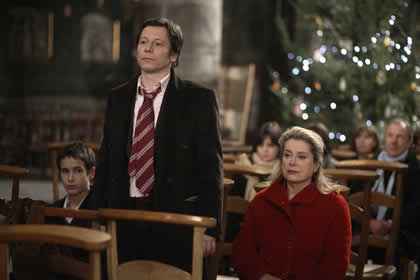 is any reconciliation, they just have to live with the fact that they disagree and that this is a part of life. They just learn how to manage with it, that you just have to experience life.
is any reconciliation, they just have to live with the fact that they disagree and that this is a part of life. They just learn how to manage with it, that you just have to experience life.
BT: During the scene with the character that speaks about his ex-wife who had died in a car accident, the camera moves while he is speaking and we see a tear on the picture. This is unusual but so interesting; how did you come up with this idea?
AD: It is an absolute loss. What I like is that in the movie, with each characters loss, they are never complaining about it. This is what it is.
BT: This film is so real, and I can tell you that after many years of seeing a Bresson film, I feel again as if I am living through a film. We live these characters. How did you come up with the visual style of the film?
AD: I can’t say that I started with a visual conception. I wouldn’t like to impose a visual conception to the movie. I work on each scene and character separately, and I try to use any kind of trick or visual style to express an idea. I do this try to make a scene slightly better, or a character slightly more moving. I am not trying to strictly have my style, but I want to use any style that can be used to 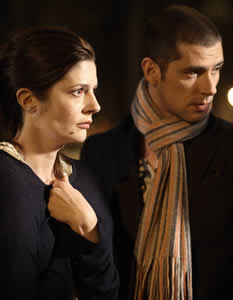 express a feeling. I think the result is that all these different ways of filming, speaking, and expressing are posted together, and the film is all these different ways of filming mixed together. This is the same with my use of music. I love to use different music in order to express something.
express a feeling. I think the result is that all these different ways of filming, speaking, and expressing are posted together, and the film is all these different ways of filming mixed together. This is the same with my use of music. I love to use different music in order to express something.
BT: There is a structure of this film that is reminiscent of old tales from the east. There is a circle in this story. In the beginning it is Joseph who has the disease, and then it is the mother who gets it. In both cases, it is the son who can help. Do you like those old ways of storytelling, mixed with your structure?
AD: Yes. The film starts with a sort of legend. In each family, we think there is an injury, but actually it is just a tale that the parents told. The family tells its own story, its own legend. This little ghost, Joseph, is floating upon the house during the whole movie; this was intended, for sure. In the writing process, I never think that I am writing something original. Each time I write a scene or line, I think about what kind of old tale it reminds me of. It is as if all the stories have been told, and a good way of retelling them is to recognize the patterns we are dealing with.

